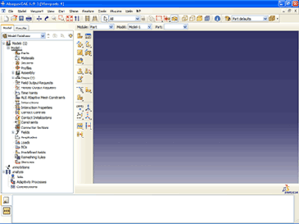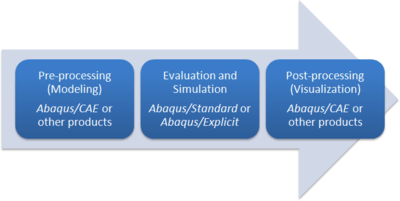Abaqus
Abaqus FEA[4][5] (formerly ABAQUS) is a software suite for finite element analysis and computer-aided engineering, originally released in 1978. The name and logo of this software are based on the abacus calculation tool.[6] The Abaqus product suite consists of five core software products:[5]
- Abaqus/CAE, or "Complete Abaqus Environment" (a backronym with an root in Computer-Aided Engineering[7]). It is a software application used for both the modeling and analysis of mechanical components and assemblies (pre-processing) and visualizing the finite element analysis result. A subset of Abaqus/CAE including only the post-processing module can be launched independently in the Abaqus/Viewer product.
- Abaqus/Standard, a general-purpose Finite-Element analyzer that employs implicit integration scheme (traditional).
- Abaqus/Explicit, a special-purpose Finite-Element analyzer that employs explicit integration scheme to solve highly nonlinear systems with many complex contacts under transient loads.
- Abaqus/CFD, a Computational Fluid Dynamics software application which provides advanced computational fluid dynamics capabilities with extensive support for preprocessing and postprocessing provided in Abaqus/CAE.[8]
- Abaqus/Electromagnetic, a Computational electromagnetics software application which solves advanced computational electromagnetic problems.
 | |
| Original author(s) | Dassault Systemes |
|---|---|
| Developer(s) | ABAQUS Inc.,[1] |
| Stable release | 6.14
/ December 31, 2018 |
| Operating system | Microsoft Windows Linux [2][3] |
| Platform | Windows/x86-32 Windows/x86-64 Linux x86-64[2][3] |
| Type | Computer-aided engineering, Finite Element Analysis |
| License | Proprietary commercial software |
| Website | www |
The Abaqus products use the open-source scripting language Python for scripting and customization. Abaqus/CAE uses the fox-toolkit for GUI development.
History
Abaqus company was founded in 1978 by Dr. David Hibbitt, Dr. Bengt Karlsson, and Dr. Paul Sorensen with the original name Hibbitt, Karlsson & Sorensen, Inc., (HKS). Later on, the company name was changed to ABAQUS Inc. before the acquisition by Dassault Systèmes in 2005. After that, it became part of Dassault Systèmes Simulia Corp. The headquarters of the company was located in Providence, Rhode Island until 2014. Since 2014, the headquarters of the company are located in Johnston, Rhode Island, United States.
Release history
| Abaqus version | Release date |
|---|---|
| 1.0 | 1979? |
| 5.4 | 1994? |
| ... | ? |
| 6.1 | ? |
| 6.2 | 2001 |
| 6.3 | 2002 |
| 6.4 | 2003 |
| 6.5 | 2004 |
| 6.6 | 2006 |
| 6.7 | 2007 |
| 6.8 | 2008 |
| 6.9 | 2009 |
| 6.10 | 2010 |
| 6.11 | 2011 |
| 6.12 | 2012 |
| 6.13 | 2013 |
| 6.14 | 2014 |
| 2016 | 2015 |
| 2017 | 2016 |
| 2018 | 2018 |
| 2019 | 2019 |
| 2020 | 2020 |
In recent years, a new version of Abaqus is released near the end of every year.
Applications
Abaqus is used in the automotive, aerospace, and industrial products industries. The product is popular with non-academic and research institutions in engineering due to the wide material modeling capability, and the program's ability to be customized, for example, users can define their own material models so that new materials could also be simulated in Abaqus. Abaqus also provides a good collection of multiphysics capabilities, such as coupled acoustic-structural, piezoelectric, and structural-pore capabilities, making it attractive for production-level simulations where multiple fields need to be coupled.
Abaqus was initially designed to address non-linear physical behavior; as a result, the package has an extensive range of material models such as elastomeric (rubberlike) and hyperelastic (soft tissue) material capabilities.
Here are some animated examples
Solution Sequence

Every complete finite-element analysis consists of 3 separate stages:
- Pre-processing or modeling: This stage involves creating an input file which contains an engineer's design for a finite-element analyzer (also called "solver").
- Processing or finite element analysis: This stage produces an output visual file.
- Post-processing or generating report, image, animation, etc. from the output file: This stage is a visual rendering stage.
Abaqus/CAE is capable of pre-processing, post-processing, and monitoring the processing stage of the solver; however, the first stage can also be done by other compatible CAD software, or even a text editor. Abaqus/Standard, Abaqus/Explicit or Abaqus/CFD are capable of accomplishing the processing stage. Dassault Systemes also produces Abaqus for CATIA for adding advanced processing and post processing stages to a pre-processor like CATIA.
Solvers Comparison
The following is a comparison between the solver capabilities of Abaqus/Standard and Abaqus/Explicit.[9]
| Feature | Common | ABAQUS/ | ABAQUS/Explicit only |
|---|---|---|---|
| Element library | Comprehensive | no limits | only elements appropriate for explicit solutions |
| Material models | Comprehensive | only yield models | yield and fracture models |
| Solution methods | Implicit Integration needs solve multiple coupled equation Using the K Matrix (F=Ku) Stable |
explicit integration step by step using small time steps sometimes not stable | |
| Required Disk Space | repetitive calculations likely takes a lot of space |
no repetitive calculation normal | |
| Types of Problems | Linear: non-linear: Contact*: usual systems** |
Can solve Can solve Can solve if simple Optimal under steady*** loads |
Can solve Optimal. even if highly non-linear Optimal. even for complex and varying conditions Optimal under transient*** loads like Impact, Pulse and Explosion |
- Notes
^* The more complex the contacts become, the more repetitive calculations ABAQUS/Standard has to solve, and the more time and disk space needed; ABAQUS Explicit is the optimal choice in this case
^** Like static elements (see the picture,) dynamic elements, thermal elements and electrical elements
^ ^*** Steady, Static and Constant loads are the same. Transient loads include: quasi-static loads (slowly varying loads in which the effect of inertial is small enough to neglect) and dynamic loads (faster varying loads).
See also
| Wikimedia Commons has media related to Abaqus FEA. |
References
- "Dassault Systemes to acquire Abaqus Inc for 413 mln usd cash". Forbes.com. Forbes. 17 May 2005. Retrieved 7 July 2010.
- "System Requirements - ABAQUS 6.12 - Dassault Systèmes®". www.3ds.com. Archived from the original on 19 August 2012.
- "Hardware & Software Certification - Dassault Systèmes®". www.3ds.com. Archived from the original on 11 December 2012.
- "Product Index". SIMULIA web site. Dassault Systèmes. Archived from the original on 29 May 2010. Retrieved 7 July 2010.
- "Abaqus FEA". SIMULIA web site. Dassault Systèmes. Archived from the original on 2 May 2010. Retrieved 7 July 2010.
- "ABAQUS CEO Interview". Archived from the original on 18 July 2014. Retrieved 4 December 2012.
- "ABAQUS 6.9 User Documentation". Internet Manual. Simulia. Archived from the original on 23 September 2011. Retrieved 10 September 2011.
- "Abaqus Unified FEA - SIMULIA™ by Dassault Systèmes®". www.3ds.com. Archived from the original on 15 November 2012.
- ABAQUS/CAE manual




